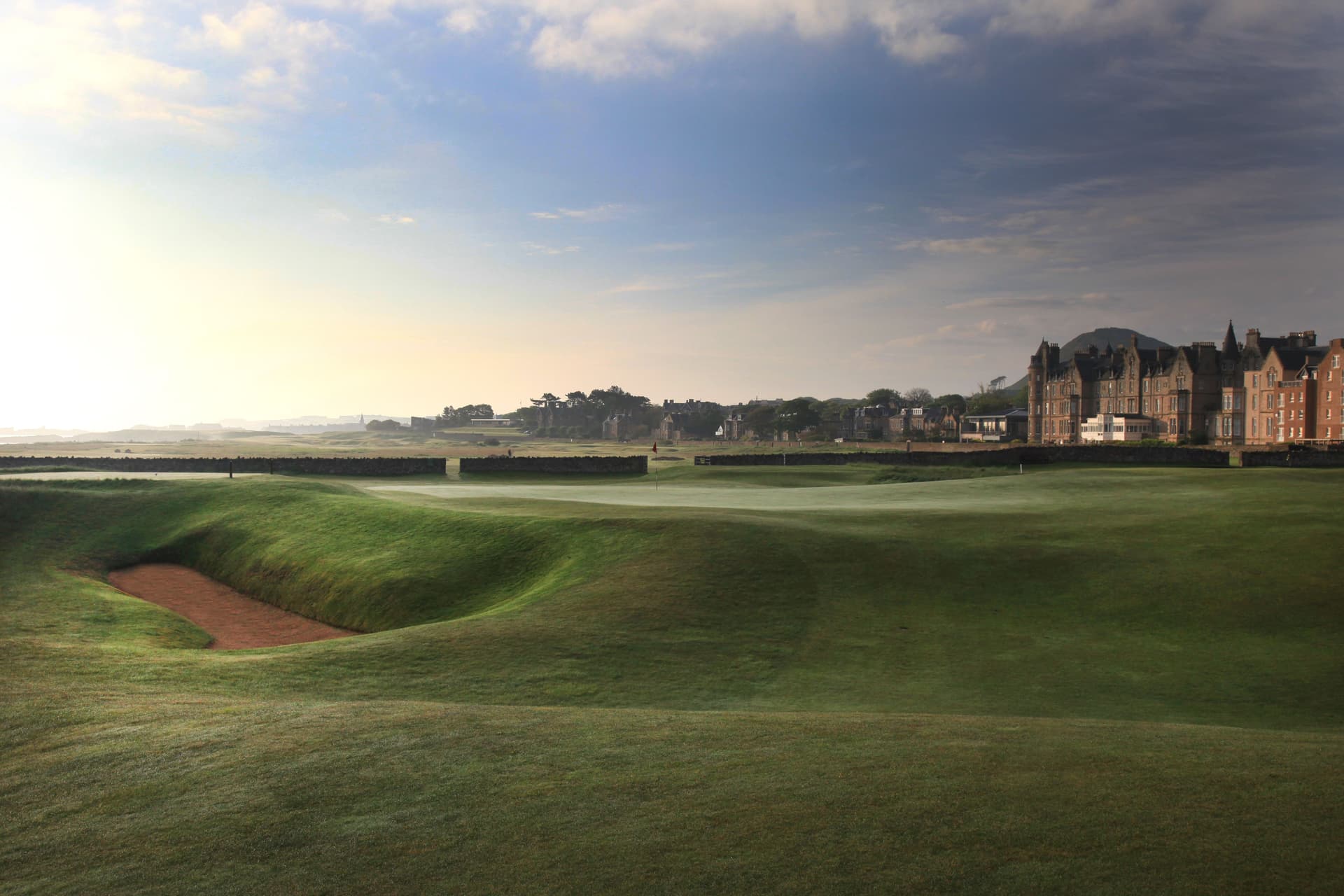
Redan – Template Holes
What is a Redan?
A Redan is golf's most celebrated template hole—a diagonal par-3 featuring a green angled approximately 45 degrees from right to left with bold slope running toward the back. Named after a Russian fortification encountered during the Crimean War's Siege of Sevastopol, the Redan rewards strategic thinking over brute force. Players who use the green's natural contours, rather than attacking the flag directly, find the most success.
First created at North Berwick Golf Club's 15th hole in Scotland, the Redan template has been replicated by legendary architects C.B. Macdonald and Seth Raynor throughout America's Golden Age of golf course architecture. Modern designers continue to build Redans today, proving this 19th-century concept remains as relevant as ever.

Quick Reference: Redan Characteristics
Origin: North Berwick Golf Club, Hole 15 (1895)
Typical Length: 180-230 yards
Green Angle: ~45° right-to-left orientation
Key Feature: The diagonal approach favours the right side
Front Bunker: Deep hazard guarding the direct route
Slope: Front portion tilts boldly left
Back Shoulder: High right side feeds balls toward pins
Named After: Redan fortification at Siege of Sevastopol
Popularised By: C.B. Macdonald (early 1900s)
The Original: North Berwick's 15th Hole
North Berwick Golf Club has several holes that we now call "templates", and it may be responsible for the greatest of them all. C.B. Macdonald—the architect most commonly associated with the template holes concept—referred to the Redan as "the finest one-shot hole in the world."
The original Redan (No.15 at the club's West Links in East Lothian) measures 190 yards to a green that turns right-to-left at an angle near 45 degrees when viewed from the tee box. Even more relevant than the degree of turn is the degree of slope, as the front portion of the green slopes boldly toward the left. The back of the green banks generously, however, to escort well-struck shots from the right side of the green to pins on the left.

The first of six key pot bunkers sits at the front-left corner of the green, to temper aggressive lines back toward the middle, but too conservative can also lead to trouble; three deep pot bunkers line the right of the green. The only safe miss is long and left, allowing the player to pitch back and putt uphill for a potential par save.

Two more bunkers sit at the fore of the green's apron, built into the side of the hill. Although beneficial to the player as reference markers—the ridge that hosts the green rises to the same altitude, possibly impairing the player's view—they can also provide visual intimidation for less confident golfers.
Although the yardage might seem quaint for the modern low handicapper, it was a rather lengthy shot back in the day. The combination of slope, relative lack of width, and the inner bunker intends to encourage a shallower draw than the lofty, more direct "dart" preferred by today's pros.

The Redan Name Origin
The template's name was apparently coined by a serving officer in the Crimean War who likened the hole to the redan fortress he'd encountered at the Siege of Sevastopol. The term refers to triangular outposts that jut out from walls to disrupt attacks. The war veteran returned to North Berwick and found the hole's green uncomfortably similar—both requiring strategic positioning rather than confrontation.
Macdonald's Definition of a Redan
C.B. Macdonald presented his definition of a Redan in his book Scotland's Gift: Golf:
"Take a narrow tableland, tilt it a little from right to left, dig a deep bunker on the front side, approach it diagonally, and you have a Redan."
This elegant definition suits two of his most famous renditions, both featured on Long Island and both considered among America's greatest golf courses.
Famous Redan Interpretations
National Golf Links of America - Hole 4
As is often the case, National Golf Links of America's take (No. 4) has become a showcase for the Redan template. Macdonald ramped up the original's features to do so, expanding the hazard from North Berwick's singular pot bunker to a trench that runs the length of the green. He also created a steeper run from the right of the green down to the left, which can funnel wayward balls back into the front hazard.
"This fourth hole at the 'National' is so good a hole that I am not sure that it is not better than the original," wrote Bernard Darwin in The Golf Courses of Great Britain.
Piping Rock Club - Redan
Perhaps not satisfied with the degree of difficulty at NGLA, Macdonald tweaked the design at the Piping Rock Club further. That iteration is an additional 10 yards in length, and the fronting bunker is both wider and longer, stretching significantly past the end of the green, perhaps to dissuade those aiming for the back-left. The traditional pot bunkers at the back are combined to form a singular trench, mirroring the defence at the front.
Swinley Forest - Hole 4
Another Golden Age classic (No. 4 at Swinley Forest) has been credited as one of Harry Colt's finest par-3 designs. The shape and distance (200 yards) obviously fit within the definition of a Redan, and the green also sits upon what Macdonald would call "tableland." The most noticeable difference is the overall gain in elevation, requiring one or two additional clubs. Two bunkers sit at the inner-left, and two rest to the right of the apron.
Swinley Forest also merits mention for opening in 1909, the same year that NGLA debuted. Clearly, C.B. Macdonald wasn't the only Golden Age architect in awe of Scotland's great holes. It's likely that Colt and his contemporaries independently created classic examples of template holes before the term was coined.
Riviera Country Club - Hole 4
Perhaps the most famous Redan, thanks to its annual PGA Tour appearances, is Riviera Country Club's No. 4 (designed by George Thomas). The hole is well beyond the traditional Redan distance, playing nearly 240 yards compared to the average (180-210 yards). That allows it, however, to play more toward North Berwick's original intent—requiring a long iron or hybrid rather than a mid-iron.
Ben Hogan referred to Riviera's 4th as "the greatest Par 3 in the world."
21st Century Redans
As perhaps the most revered template, the Redan has newfound popularity in the current era of golf course design. Contemporary architects have embraced the strategic principles while adapting them to modern sites and playing conditions.
Pacific Dunes - Hole 17
Tom Doak labelled his effort at Bandon Dunes' Pacific Dunes (No. 17) as the favourite Redan he's built—a big claim from a man who, with Jim Urbina, crafted a Macdonald-inspired 18 at the very same resort with its own Redan (No.12 at Old Macdonald). Playing a traditional distance, the hole at Pacific Dunes embraces the resort's naturalist aesthetic in its front bunker. Although the back hazard is considerably wide of the green, players may become distracted by the backing wall of yellow gorse when in bloom.

Sand Valley - Hole 3
Bill Coore and Ben Crenshaw brought the Redan to their own Mike Keiser project. Sand Valley features a lengthy (225 yards) par-3 where the right hump is not actually on the green, but the skirt. Played properly, it will kick onto the green in true Redan fashion. Improperly, and the player will be pitching downhill from the right.
Redan Greens on Par 4s and Par 5s
It is entirely possible for a par-4 or par-5 to have a Redan green. Several courses, such as Seth Raynor's Blue Mound Golf & Country Club, feature both a par-3 and par-4 rendition. This demonstrates how the Redan concept can be applied to approach shots of varying lengths. Too much of a good thing? Not for Raynor.
How to Play a Redan Hole
Strategic Approach
Aim for the high back-right shoulder of the green, allowing the natural slope to feed your ball left and down toward the pin. This is the strategic route that Macdonald intended.
Redan Variations
- Traditional Redans (180-200 yards)
- Long Redans (220+ yards)
- Elevated Redans
- Reverse Redans
- Firm conditions: Consider running approach from the right
Long and left is the only safe miss on a Redan. This position allows an uphill pitch with a makeable par putt.
Are They True Redans?
Shinnecock Hills - Hole 7
Fans of Golden Age architecture are the staunchest proponents of the Redan... but even they might be willing to admit No. 7 at Shinnecock Hills may not qualify. Indeed, the idea is there but many—including a host of U.S. Open competitors—have reason to argue otherwise.
To quote Tom Doak: "I don't think the slope in front of the green allows you to play the bank shot from the right with any high percentage of probability...if you aim for that spot and the ball takes one big bounce, you're over the back right and looking at double bogey."
Perhaps by moving the position of the teeboxes, Shinnecock's 7th would provide a more realistic angle of approach, and fully justify the Redan moniker?
TPC Sawgrass - Hole 13
Claims that No. 13 at TPC Sawgrass is a modern Redan also require significant consideration. The issue is not so much the water that runs along the left-hand side (a typical Pete Dye diversion), and certainly not the hole's expected right-to-left play. Rather, it's whether the best approach is actually to play it like a Redan.
The portion of the green at the front left is unnaturally flat and large enough to hold a well-struck dart. Attempting to arrive at these flags by riding the slope may actually prove more difficult. On the flip side of the coin, the ridge that divides the green flags at the back left receives an occasional ace during The Players Championship when the pros take a Redan route.
The difference is the spine, and on which side the flag stands that day. Can it be a Redan one day, and a non-Redan the next?
Frequently Asked Questions About Redans
What is a Redan hole in golf?
A Redan is a par-3 hole with a diagonal green angled approximately 45 degrees, sloping right-to-left. The design encourages golfers to use the green's contours rather than attack directly, rewarding strategic play over the bunker-guarded front approach.
Where is the original Redan hole?
The original Redan is the 15th hole at North Berwick Golf Club's West Links in East Lothian, Scotland, designed by Ben Sayers around 1895.
What makes a true Redan hole?
According to C.B. Macdonald: "Take a narrow tableland, tilt it a little from right to left, dig a deep bunker on the front side, approach it diagonally, and you have a Redan." Key features include diagonal orientation, bold tilt and green slopes, strategic bunkering, and a high back-right shoulder.
Why is it called a Redan?
A Crimean War officer likened the hole to a redan fortress at the Siege of Sevastopol. Redans are triangular fortifications offering flanking defence—similar to how the hole's angle defends against direct assault.
What is a Reverse Redan?
A Reverse Redan mirrors the traditional design, sloping left-to-right instead of right-to-left. The same strategic principles apply, but in reverse orientation.
Who built the most famous Redan holes?
C.B. Macdonald and Seth Raynor built numerous Redans across America during the Golden Age. Macdonald's version at National Golf Links of America is considered by many to be superior to the original.
How do you play a Redan hole successfully?
Aim for the high back-right shoulder and let the slope feed your ball left toward the pin. Avoid the front-left bunker, and remember that long and left is the only safe miss.